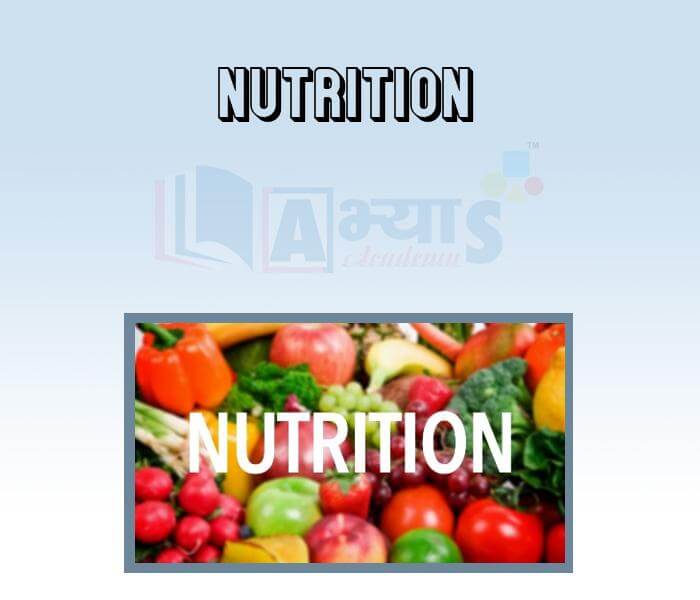Nutrition


Nutrition
Nutrition
· It is the process to transfer source of energy (food) from outside to the body for maintaining living structure of an organism.
· It provides nutrients to the body so that it can obtain energy to carry out the activities required to stay alive. ‘Nutrients’ are substances that give nourishment which provides energy to an organism. The digestive system of an organism breaks down complex food into simpler molecules, so that the cells can take them and use for survival, growth and reproduction.
· Nutrition promotes growth of the body, which involves the formation of new protoplasm. Nutrition meets the energy requirement of the body. It helps to synthesize a variety of substances like: proteins, carbohydrates, fats etc.
Modes of Nutrition
Plants and animals do not obtain food by the same process. Plants and some bacteria have the green pigment ‘chlorophyll’ to help synthesize food, while animals, fungi and other bacteria depend on other organisms for food. There are two modes of Nutrition:
1. Autotrophic Nutrition 2. Heterotrophic Nutrition
Difference between the two modes of Nutrition
| Autotrophic Nutrition | Heterotrophic Nutrition |
1 | It occurs in green plants, some bacteria and in some plants. | It occurs in fungi and animals |
2 | Chlorophyll is necessary for trapping solar energy. | Chlorophyll is absent; as such they do not trap solar energy. |
3 | Food is self manufactured using CO2 and water as raw material | Food is obtained directly or indirectly from autotrophs. |
4 | Digestion of food does not occur. | Digestion is required to convert complex organic substances into simpler form |
5 | They are placed at the bottom of the food chain as producers. | They are placed above producers in the middle of food chain as consumers. |
6 | e.g.: plants, blue – green algae | e.g.; animals including humans |
The process by which food is taken in by an organism and used by body is called ____________________ | |||
| Right Option : B | |||
| View Explanation | |||
The process of taking in food and utilizing it for the growth and development is known as_________ | |||
| Right Option : B | |||
| View Explanation | |||
There are ______________ modes of nutrition. | |||
| Right Option : B | |||
| View Explanation | |||
Students / Parents Reviews [10]
One of the best institutes to develope a child interest in studies.Provides SST and English knowledge also unlike other institutes. Teachers are co operative and friendly online tests andPPT develope practical knowledge also.

Aman Kumar Shrivastava
10thAbhyas is a complete education Institute. Here extreme care is taken by teacher with the help of regular exam. Extra classes also conducted by the institute, if the student is weak.

Om Umang
10thMy experience with Abhyas academy is very good. I did not think that my every subject coming here will be so strong. The main thing is that the online tests had made me learn here more things.

Hiya Gupta
8thAbout Abhyas metholodology the teachers are very nice and hardworking toward students.The Centre Head Mrs Anu Sethi is also a brilliant teacher.Abhyas has taught me how to overcome problems and has always taken my doubts and suppoeted me.

Shreya Shrivastava
8thMy experience with Abhyas is very good. I have learnt many things here like vedic maths and reasoning also. Teachers here first take our doubts and then there are assignments to verify our weak points.

Shivam Rana
7thMy experience was very good with Abhyas academy. I am studying here from 6th class and I am satisfied by its results in my life. I improved a lot here ahead of school syllabus.

Ayan Ghosh
8thBeing a parent, I saw my daughter improvement in her studies by seeing a good result in all day to day compititive exam TMO, NSO, IEO etc and as well as studies. I have got a fruitful result from my daughter.

Prisha Gupta
8thI have spent a wonderful time in Abhyas academy. It has made my reasoning more apt, English more stronger and Maths an interesting subject for me. It has given me a habbit of self studying

Yatharthi Sharma
10thIt was a good experience with Abhyas Academy. I even faced problems in starting but slowly and steadily overcomed. Especially reasoning classes helped me a lot.

Cheshta
10thIt was good as the experience because as we had come here we had been improved in a such envirnment created here.Extra is taught which is beneficial for future.
